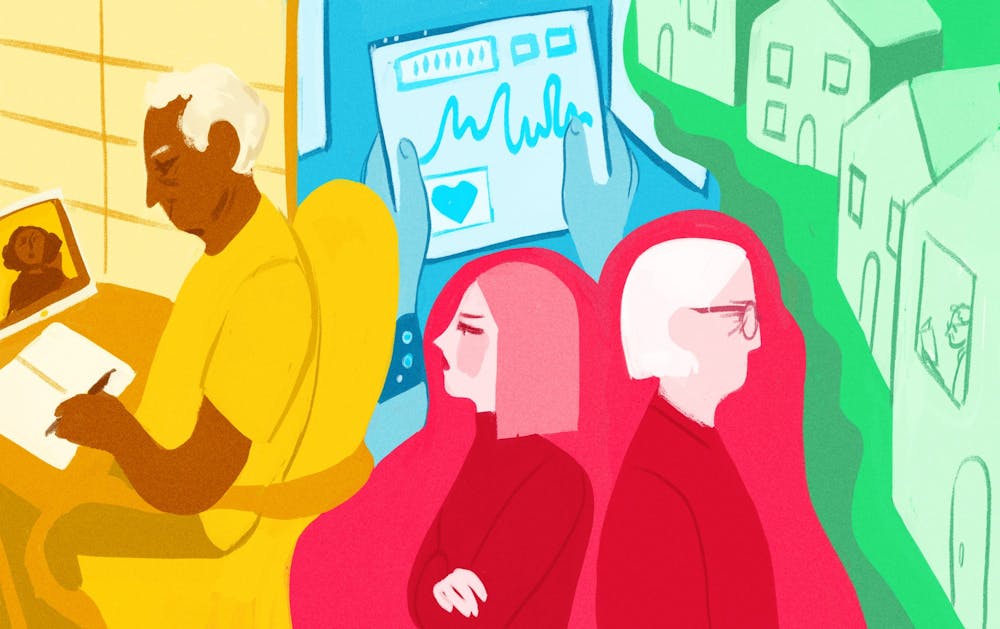In the report "The Future of Ageing in Smart Environments," ASU assistant professor Lauren Withycombe Keeler and assistant research professor Michael Bernstein explore how changing technology and an aging society could shape the future.
The four scenarios, “How Terribly Strange to Be 90,” “Well Assisted,” “Live Free & Die Free” and “Final Nesting Place,” describe possible outcomes of aging with evolving technology in 2050.
The scenarios, split into quadrants, describe a different hypothetical world in which older adults interact with technology and society.
In "How Terribly Strange to Be 90," people are expected to live and work longer, have a better understanding of technology and multi-generational living situations are common.
"Well Assisted" describes a society where people live and work longer and multi-generational living is economically necessary. The "Live Free & Die Free" scenario has age-segregated communities that are too expensive for most people and social safety programs are reduced. In "Final Nesting Place," lifespans are extended, and most people live with other people their age.
The report received funding from the KAITEKI Institute at Mitsubishi Chemical Holdings Corporation, a company based in Japan. Keeler said Japan and the U.S. are both "aging societies," meaning older adults make up a higher proportion of the population.
“In the beginning, we proposed to the KAITEKI Institute a set of tools that would help them think about how their business can do good in society in a future that is different from the present,” Keeler said.
Bernstein said organizations can use the four scenarios to help decide how to prepare for the future. Possible decisions may include adapting health care and technology to make them more accessible to older populations.
The report began at a workshop hosted by the School for the Future of Innovation in Society and the Global KAITEKI Center of ASU.
In the workshop, 36 experts from a variety of fields gathered to discuss what trends might shape the future of aging in smart environments. Some elements of smart environments outlined in the report include artificial intelligence, virtual reality and holographic communication.
From those trends, the group came up with two major drivers of change in the future: level of individual choice about technology and level of social integration. These two factors became the axes on which the four scenarios were placed.
Levels of individual choice may involve choices about what devices people have in their homes and their bodies, Keeler said. Levels of integration are shown in whether aging people live among the rest of society and if they have good relationships with other parts of society.
For example, the scenario “How Terribly Strange to Be 90” sits in the quadrant with high social integration and high individual choice about technology, while “Final Nesting Place” is characterized by low social integration and low individual choice about technology.
Keeler said the scenarios are meant to give people and organizations a chance to assess what they can do to succeed in the future.
“The future is not going to be any one of these scenarios, it's going to be a composite of different elements of each," Bernstein said.
In addition to explanations and analyses of each scenario and the report as a whole, the report offers four narratives inspired by each scenario.
Andrew Dana Hudson, a speculative fiction writer and graduate student studying sustainability, worked on writing these stories.
The stories follow families and aging individuals through discussions people might find familiar but with higher levels of technology and differing attitudes surrounding age.
In one of the stories, a Los Angeles family spends Christmas discussing when people should retire given the new longevity treatments that can extend the time someone is able to work.
When writing the narratives, he said he thought about points of contradiction in the scenarios that could highlight differences between how people feel about the present and future and the complexity of how people relate to the situations they are in.
“The biggest challenge is people feeling unwilling to imagine or pursue exciting future opportunities because they can't see a place for themselves,” Hudson said.
Hudson said the goal of the stories is "to help people see these possibilities and put themselves in it" to understand what life as a member of the aging population is like.
While the report offers detailed insights into the four scenarios, Keeler said it is more of a prompt for people to think about the future in different ways than they do now than a play-by-play prediction.
"The idea is not to just read them, like tea leaves, telling you what the future will hold," Keeler said. "The futures themselves are only useful if we can turn them back on ourselves and reevaluate what we care about and what we're capable of."
Reach the reporter at gforslun@asu.edu and on Twitter @GretaForslund.
Like The State Press on Facebook and follow @statepress on Twitter.




